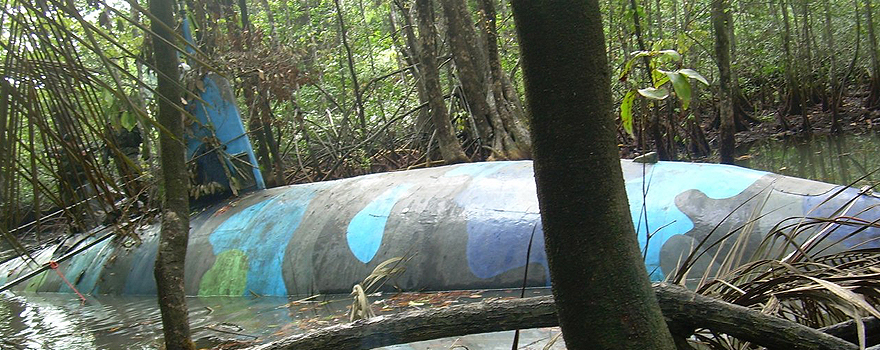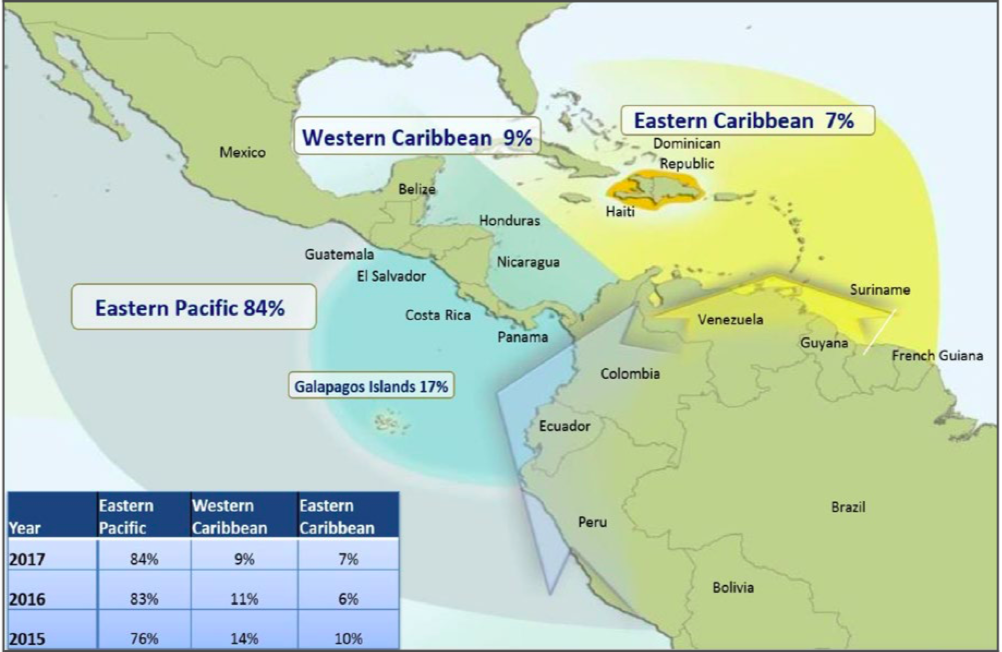The United States remains attentive to the innovation of methods that can also serve to introduce terrorist cells or even weapons of mass destruction
In the last ten years, the proliferation of submersible and semi-submersible, with difficult detection, has monopolized a third of the drug transport from South America to the United States. The incorporation of GPS systems by the cartels also makes the global fight against narcotics difficult. A possible use of these new methods for terrorist purposes keeps the United States on high alert.

▲ A narco-submarine found in the jungle of Ecuador in 2010 [DEA]
ARTICLE / Marcelina Kropiwnicka [Spanish version]
Drug trafficking to large consumer markets, especially the United States and Europe, is especially innovative: the magnitude of the business leads to attempts in overcoming any barriers placed by the States to prevent their penetration and distribution. In the case of the United States, where the illicit arrival of narcotics dates back to the 19th century–from opium to marijuana and cocaine–, authorities have continuously managed to intercept many shipments of drugs, but traffickers find new ways and methods to introduce significant volumes of narcotics.
The most disturbing method in the last ten years has been the use of boat submersibles and semi-submersibles, which have commonly been given the name of narco-submarines. They allow several tons of substances to be transported–five times more than a fishing boat can transport–dodging the US Coast Guard's surveillance [1]. Satellite technology has also led traffickers to drop drug loads into the sea, then be collected by recreational boats without raising suspicion. Those methods are referenced in recent reports from the Drug Enforcement Administration (DEA), the US anti-narcotics agency.
Through the waters of Central America
For many years, the conventional way of transporting drugs that leave South America to the United States has been through fishing boats, speedboats and light aircraft. Advances in airborne detection and tracking techniques have pushed drug traffickers to look for new ways to take their loads to the North. Hence the development of narco-submarines, whose number, from a first interception in 2006 by the US authorities, has seen a rapid progression.
This means of transport is one of the reasons that since 2013 there has been a 10% increase in trafficking of drugs that travel from Colombia (the country that produces 93% of the cocaine consumed in the US) to Central America and Mexico, the location where the shipments are introduced to the US. According to the DEA, this corridor today represents an estimated 93% of the movement of cocaine from South America to North America, compared to 7% of the route that passes through the Caribbean islands (mainly the Dominican Republic) to reach Florida or other places on the East American coast.
For a while, among US Coast Guard service members spread a rumor that the drug cartels were using narco-submarines. Without having seen one up to that moment, the agents gave it the name of 'Bigfoot' (like the supposed ape-like animal that would inhabit Pacific forests in the US).
The first sighting occurred in November 2006, when a patrolman from the US Coast Guard detected a blurred shape in the ocean, about a hundred miles off the coast of Costa Rica. As the agents approached the blur, they discovered three tubes of plastic that emerged from the water, which came from a submersible ship that was two meters below the surface. Inside the submersible they found three tons of cocaine and four men armed with an AK-47 rifle. The coastguard named the discovery as 'Bigfoot I'.
Two years later there would be detection of a 'Bigfoot II'. In September 2008, a frigate of the US Navy working with the Coast Guard seized a similar apparatus 350 miles from the border between Mexico and Guatemala. The crew consisted of four men and the cargo reached 6.4 tons of cocaine.
By then, the US authorities calculated that more than one hundred submersibles or semi-submersibles had been crafted. In 2009 they estimated that they were only able to stop 14% of shipments, and that this method of transport provided at least one third of the total cocaine shipment reaching the US market. The Colombian, Mexican and Guatemalan armies have also confiscated some of these narco-submarines. In addition to being located in the Pacific, they have also been detected in the Caribbean and the Atlantic. Crafted in the jungle, perhaps the most striking discovery was in the interior of Ecuador, in the waters of a river.
Its technical innovation has often surprised counter-narcotics officials. Many of these self-propelled narco-submarines measure fifteen meters, are made of synthetic materials and fiberglass and have been designed to reduce their detection by radar or infrared. There have also been models with systems of GPS navigation to refuel and receive food at agreed points along their established route.
GPS tracking
The development and generalization of the GPS system has also served drug traffickers to introduce greater innovations. One procedure, for example, has been to fill a vessel shaped like a torpedo with drugs–like a submersible, but without a crew–, and attached to a buoy and a signal emitter. The container can hold up to seven tons of cocaine and be fastened to the bottom of a ship by a cable. If the boat is intercepted, the container can simply be dropped deeper into the water, and can later be recovered by another boat thanks to satellite locators. This makes it extremely difficult for authorities to seize the drugs and stop the traffickers.
The GPS navigation system is also used to deposit drug cargos at points in the territorial waters of the United States, where they can be collected by recreational craft or by a small group of people without raising suspicion. The package containing the cocaine is coated with several layers of material and then waterproofed with a type of foam. The package is placed inside of a canvas bag that is then deposited into the bottom of the sea to be recovered by others later on.
As indicated by the DEA in its 2017 report, “this demonstrates how trafficking organizations have evolved their methods for conducting cocaine transactions through technology Organizations transport kilograms of cocaine in waterproof packaging to a predetermined location, anchor it to the ocean floor for retrieval by other DTO [Drug Trafficking Organization] members who have the contraband GPS location. This allows members of trafficking organizations to compartmentalize, as it separates maritime transporters from land-based cocaine distributors.”
|

Cocaine routes from South America to the United States in 2017 [DEA]
|
Terrorist risk
The possibility that these difficult detection methods are being used to introduce weapons or for terrorist operations worries the United States authorities. Retired Vice Admiral James Stravidis, former commander of US Southern Command, has warned of the potential use, especially of the submersibles, “to transport more than just narcotics: the movement of cash, weapons, violent extremists, or, at the dark end of the spectrum, weapons of mass destruction.”
This risk was also referred to by Rear Admiral Joseph Nimmich when, as commander of the Joint Interagency Task Force South, he faced the emergence of submersibles. “If you can carry 10 tons of cocaine, you can carry 10 tons of anything,” he told The New York Times.
According to this newspaper, the furtive elaboration of homemade submarines was developed first in Sri Lanka, where the rebel group of the Tamil Tigers used them in confrontation with government forces. “Tamil will go down in history as the first terrorist organization to develop underwater weapons,” said the Ministry of Defense of Sri Lanka. In 2006, as the NYT states, “a Pakistani and a Sri Lankan provided plans to the Colombians for building semisubs quickly, stealthily and out of cheap, commonly available materials.”
Despite its origin, related to the Tamil rebels, and the terrorist potential presented by the submersibles used by the drug cartels, the fact is that Washington has not yet reported evidence that these new methods of drug transport developed by organized crime groups are being used by other extremist actors. Nevertheless, the US maintains on high alert due to an increased rate of shipments arriving to their destination without detection.
[1] REICH, S., & Dombrowski, P (2017). The End of Grand Strategy. US Maritime Pperations in the 21st Century. Cornell Univesity Press. Ithaca, NY. Pag. 143-145